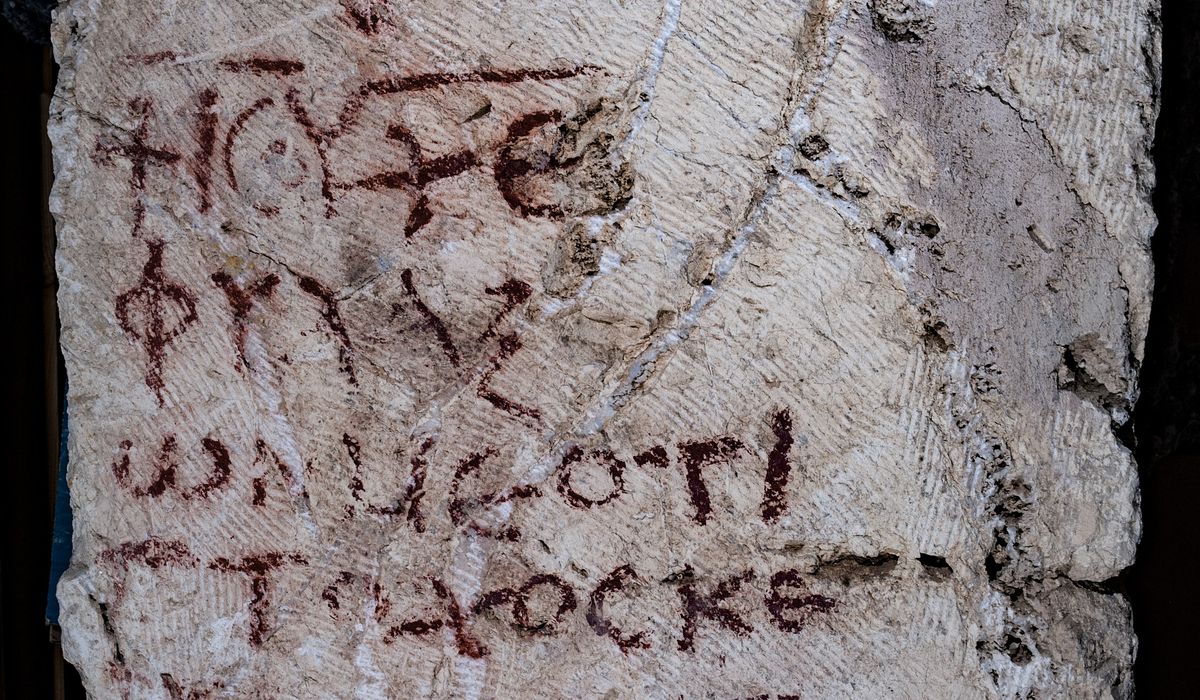


An ancient inscription paraphrasing the first two verses of Psalm 86 has been uncovered at a remote site in Israel’s Judean desert, archaeologists from the Hebrew University of Jerusalem said Wednesday.
The Byzantine Greek inscription, which dates from the early 6th century, was found on a monastery’s building stone at a dig site where there are no roads for vehicle access, university teaching fellow Oren Gutfeld told The Washington Times via telephone from a field location. His team had to use donkeys to transport equipment to the site.
The find is “the first time that I recall a phrase from the Psalms on an inscription [on a] huge stone building stone. It’s very, very rare — a unique something [that’s] bigger than the inscription itself,” Mr. Gutfeld said.
Marked with a cross, the biblical inscription reads: “Jesus Christ, guard me, for I am poor and needy.” The first two verses of Psalm 86 say, “Hear me, Lord, and answer me, for I am poor and needy. Guard my life, for I am faithful to you,” according to the New International Version.
“This psalm holds a special place in the [Hebrew] Masoretic text as a designated prayer and is notably one of the most frequently recited psalms in Christian liturgy,” epigraphist Avner Ecker of Bar-Ilan University said in a statement. “Thus, the monk drew a graffito of a cross onto the wall, accompanied by a prayer with which he was very familiar.”
The inscription’s “minor grammatical errors” offer a clue about its author, Mr. Ecker said.
“These minor errors indicate that the priest was not a native Greek speaker but likely someone from the region who was raised speaking a Semitic language,” he said in the statement.
The university said the location is roughly 10.5 miles southeast of Jerusalem and 5 miles from Qumran and the Dead Sea.
Mr. Gutfeld told The Times that it was fortunate that the portion of the site where the stone was found had not been looted. The nearby foothill contains “a big Second Temple period cemetery that has been looted for many, many years,” he said.
The koine, or “common,” Greek inscription was found on what the archaeologists described as “a sizable building stone” at a monastery at a former fortress called Hyrcania, which dates to the late second or early first century BCE.
Hyrcania was abandoned around 4 BCE. In 492 CE, a monk named Holy Sabbas established a small Christian monastery there, known as the Kastellion — the “Little Castle,” in Greek.
Hebrew University said the Islamic conquest of Byzantine Palestine, around 635 CE, did not stop the monastery’s operations. However, the monastery “was apparently abandoned” by the early 9th century.
In the 1930s, the school said, there was an effort to revive the monastery, but local Bedouins harassed those who tried, thwarting the attempt.
The university said this was the site’s first methodological, academic excavation.
The school’s Mr. Gutfeld and doctoral student Michal Haber led the effort, assisted by students and faculty from Carson-Newman University in Jefferson City, Tennessee, and former U.S. service members associated with American Veterans Archaeological Recovery.
Mr. Gutfeld told The Times they hope to use advanced technology previously used in 2016 to decipher an ancient scroll too fragile to unroll as they seek to translate another stone with an Arabic inscription in the kufic style of calligraphy.
“It’s very, very difficult to understand and to read that inscription, but we’re looking forward that, with the technology that we have today, we will be able to read it and to add the information” of their findings, he said.
• Mark A. Kellner can be reached at mkellner@washingtontimes.com.
